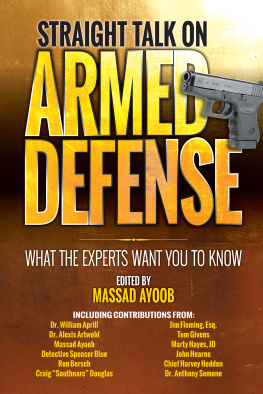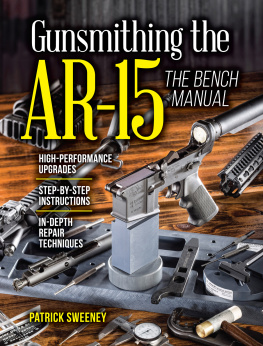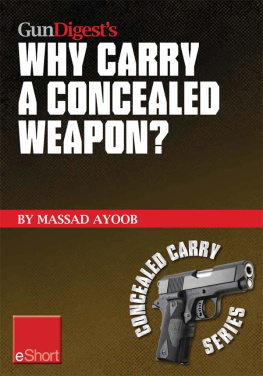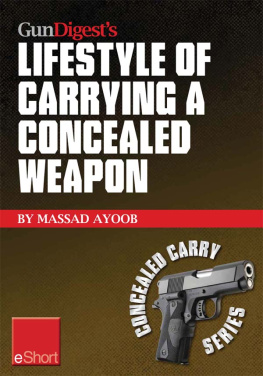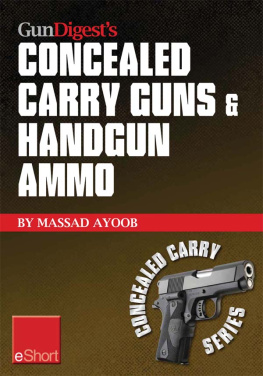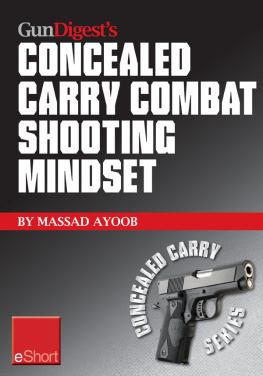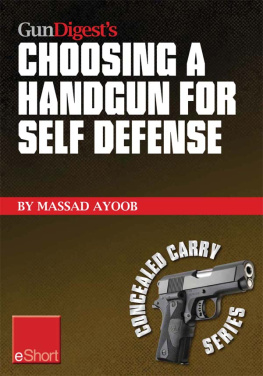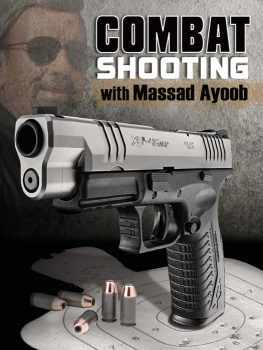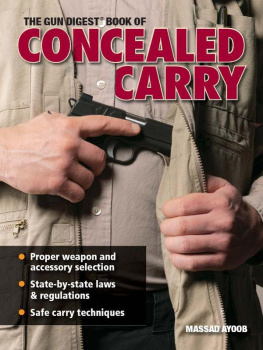Thank you for purchasing this Gun Digest eBook.
Sign up for our newsletter and receive special offers, access to free content, and information on the latest new releases and must-have firearms resources! Plus, receive a coupon code to use on your first purchase from GunDigestStore.com for signing up.
or visit us online to sign up at
http://gundigest.com/ebook-promo
TABLE OF CONTENTS
INTRODUCTION
BY MASSAD AYOOB
This book differs from my previous twenty (counting the occasional updated edition) in that it is a collection. The idea was born not in my office, but in the offices of the publisher when Gun Digest Medias Jim Schlender suggested it to me. While there are excellent books in each of the specialty fields encompassed in this selection, I dont believe this particular approach a gathering of a dozen SMEs (subject matter experts) each addressing the specific element of threat management for which they are most famous has been done yet in the self-defense field.
Why this approach? Because threat management, as it encompasses self-defense and defense of other innocent parties, is a multi-dimensional discipline. Each of those dimensions can be a life study in and of itself. Moreover, its a living discipline in which theory and practice evolve as the threats evolve. Those who do not follow change and absorb it (or fight it when it goes in the wrong direction!) tend to fossilize and become obsolete. Threat management is a classic example of the old saying, As soon as you think you have all the answers, the bastards change the questions.
In nineteen years as chair of the firearms/deadly force training committee for the American Society of Law Enforcement Trainers, thirteen or so years on the advisory board of the International Law Enforcement Educators and Trainers Association, et cetera, Ive taken advantage of the networking that such professional seminars offer. It has allowed me to learn from the best and the brightestand to invite them to contribute to this book. Happily, they all accepted that invitation.
In the early stages of the collection process, I considered at first organizing the material into the three stages of crisis management: prevention, intervention, and postvention.
Prevention: We knew the bad thing might happen. We saw it coming. We put bulwarks in place to keep it from happening. If the crisis in question involved human aggression instead of uncontrollable things like hurricanes and tornadoes, we may have created a level of intimidation that made the aggressor realize it was not in his best interest to attack, and thus prevented the attack by deterring the potential attacker. Prevention is always the ideal.
Intervention: For whatever reason, the attack was not prevented. The prevention efforts may have failed, or been in the wrong place at the wrong time, or simply non-existent. It is HAPPENING NOW! At this point, we must intervene: break or at least stall the attack. Prevent further harm to the innocent. Freeze the situation where it is, with no further damage to those who we have determined it is our righteous and lawful need to protect.
Postvention: A term so seldom used most people wont recognize it. (Spellcheck doesnt recognize it either, it turns out.) Its over. All we can do is pick up the pieces. It is in this stage of crisis management that we bury the dead, heal the wounded, and console their loved ones. The legal aftermath of an incident falls into the postvention stage. The Critical Incident Debriefing occurs in the postvention stage, too, and before even that will come the investigation of the matter. Does that fall under postvention, too? Yes, most certainly.
Why, then, is this book not divided into those three sections after all? It is because, sequential as they obviously are, there is too much overlap. For example, the lessons learned from the investigation and the post-incident debriefing will feed back into the next and subsequent cycles of training, planning, and preparation. That improved training, those updated and hopefully better informed policies, will be there to guide the next cop or citizen who faces the next outbreak of deadly criminal violence.
Thus, the triad of prevention/intervention/postvention is not a three-act play. Because successful intervention flows from training that was given at least in part in hopes of prevention; because what was done during the intervention phase will be the focus of the postvention stage; and because the lessons from postvention will feed back into the next cycle of preventative training, the three are more like a continuously moving circle whose three stages are frequently mixed into one another.
PERSPECTIVES
When we discuss emotionally-charged topics that involve people being in mortal fear, we must be able to see the forest for the trees. Theres a saying in the world of personal self-defense training: Its not about the odds, its about the stakes.
I ask my civilian students, Do you have fire insurance on your home? Of course, most raise their hands. My next question is, Have you had your house burn down? Occasionally, a student does raise his or her hand. Damn glad you had the insurance, werent you? I ask, and the response is always an enthusiastic Yes.
Finally, I ask, Does anyone feel that you were cheated by the insurance company if your house didnt burn down? Is anyone sitting here now thinking Damn, my house never burned down, so I lost the bet and Im a loser? They laugh, and shake their heads in the negative.
What were talking about in this book is a direct allegory to that. If your house doesnt burn down, the premiums you paid on fire insurance were still worth it. Partly for the peace of mind it gave you knowing it was there, and partly because if that horrible thing happened, it could be dealt with.
Being armed and ready to act in self-defense against a lethal threat is much the same. If you are one of the great majority who never needs to pull the trigger, the money you spent on self-defense training and equipment wasnt wasted; it gave you full value in peace of mind. But, if it did happenwell, you were damn glad you were prepared and ready for it.
Were going to start with understanding the mindset of it all, and well start with understanding ourselves. Why that, and not begin with understanding the enemy? Because not all life-threatening crisis involves a lethally dangerous criminal coming at you and your family. We live finite lives in a dangerous world. Deadly danger is deadly danger. Whether its a hand-to-hand fight or a gunfight, or a car crash or plane crash or natural disaster or someone we love collapsing from a heart attack before our very eyes, our reactions to lethal danger will be much the same. The shape of what were facing may change, but what we bring to that critical incident will be pretty much the same.
KNOWING AND UNDERSTANDING YOUR LIKELY OPPONENT IS CRITICALBUT KNOWING AND UNDERSTANDING YOURSELF MAY WELL BE MORE IMPORTANT.
The years have taught me that knowing and understanding your likely opponent is criticalbut knowing and understanding yourself may well be more important.
How our minds and bodies work in crisis is something we must know if were going to program that mind and body to fight and prevail in a life-or-death situation. I have known John Hearne for many years, and consider him one of the rising stars in the training world. He has spent his adult life studying this topic and correlating it with his deep research into actual gunfights. A champion combat pistol shooter and a career federal law enforcement officer, Hearne has been able to debunk and dispel a great deal of junk science that was formerly applied to this discipline (and still is, by some). His eight-hour presentation on this topic is a highlight of every national Rangemaster Tactical Conference, and his chapter seemed the most logical point at which to start the body of this book.

